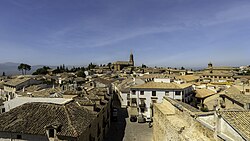Baeza | |
|---|---|
 Skyline, with the Cathedral at the centre. | |
 Location of Baeza | |
| Coordinates: 37°59′N 3°28′W / 37.983°N 3.467°W | |
| Country | Spain |
| Autonomous community | Andalusia |
| Province | Jaén |
| Government | |
| • Mayor | Pedro Javier Cabrera Rentero (PP) |
| Area | |
| • Total | 194.3 km2 (75.0 sq mi) |
| Elevation | 769 m (2,523 ft) |
| Population (2018)[1] | |
| • Total | 15,902 |
| • Density | 82/km2 (210/sq mi) |
| Demonym | Baezanos |
| Time zone | UTC+1 (CET) |
| • Summer (DST) | UTC+2 (CEST) |
| Postal code | 23440 |
| Website | Official website |
| Part of | Renaissance Monumental Ensembles of Úbeda and Baeza |
| Criteria | Cultural: (ii), (iv) |
| Reference | 522rev-002 |
| Inscription | 2003 (27th Session) |
| Area | 4.8 ha (12 acres) |
| Buffer zone | 176 ha (430 acres) |
Baeza[n. 1] (Spanish pronunciation: [baˈeθa]) is a city and municipality of Spain belonging to the province of Jaén, in the autonomous community of Andalusia. It is part of the comarca of La Loma. The present name was established in Roman times as Vivatia, then Biatia by the Visigoths, Bayyasa by the Moors from the 8th century onwards; until it became Baeza.
It is now principally famed for having some of the best-preserved examples of Italian Renaissance architecture in Spain. Along with neighbouring Úbeda, it was added to UNESCO's list of World Heritage Sites in 2003. The former Visigothic bishopric of Baeza remains a Latin Catholic titular see.
- ^ Municipal Register of Spain 2018. National Statistics Institute.
- ^ EB (1911).
Cite error: There are <ref group=n.> tags on this page, but the references will not show without a {{reflist|group=n.}} template (see the help page).

